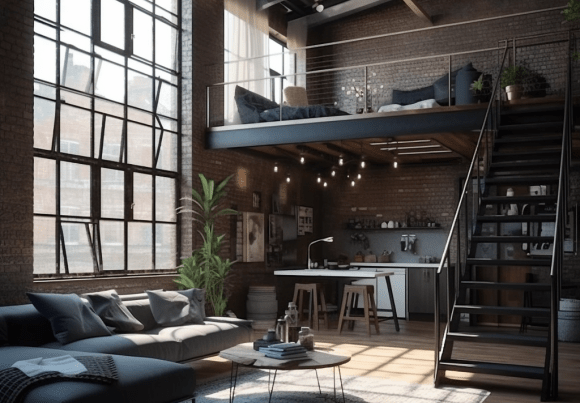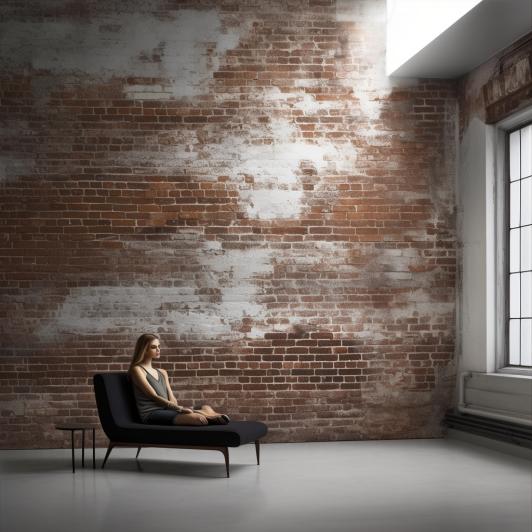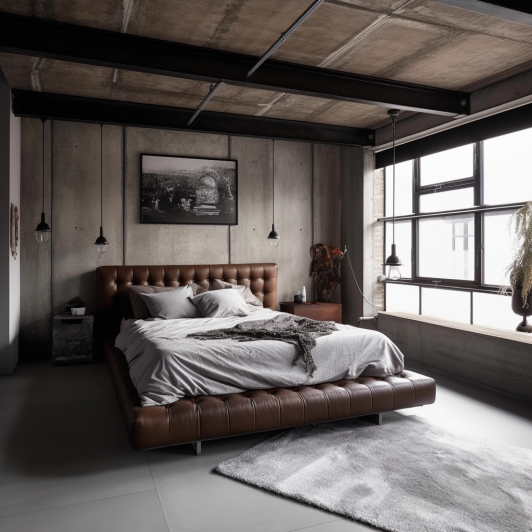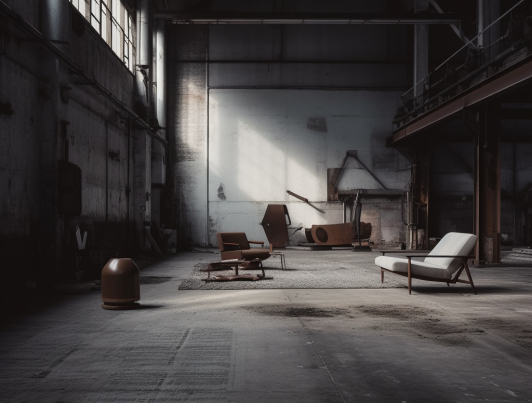TABLE OF CONTENTS:

Introduction
Industrial wall ideas have taken the world of interior design by storm, transforming ordinary spaces into stunning showcases of raw, unrefined charm. Embracing the beauty of exposed materials, neutral palettes, and functional elements, this design trend is perfect for those seeking a unique and edgy aesthetic. In this guide, we will delve into the captivating world of industrial wall ideas, exploring the essential elements, offering tips for creating the perfect industrial wall, and providing inspiration for various spaces within your home.
History and Origins of Industrial Design

Early 20th Century Factories and Warehouses
The history of industrial design can be traced back to the early 20th century when factories and warehouses played a pivotal role in shaping the aesthetic. These functional spaces were characterized by exposed brick, steel beams, and vast open floor plans, which later became synonymous with the industrial style. As industrialization advanced, these spaces were often abandoned or repurposed, eventually inspiring the industrial design trend that we recognize today.
Emergence of the Loft Living Trend
The loft living trend emerged in the mid-20th century, particularly in urban areas where old factories and warehouses were converted into residential spaces. These lofts retained the original architectural elements, such as high ceilings, large windows, and exposed infrastructure, which became desirable features for living spaces. Loft living allowed for a seamless blend of living and working environments, ultimately contributing to the popularization of the industrial design movement in residential interiors.
Key Elements of Industrial Wall Design
Industrial wall design incorporates a variety of raw, textured, and functional elements to create a distinctive and captivating look. Some of the key components that define this design style, are exposed brick, concrete surfaces, metal accents, weathered wood, and a neutral colour palette. By understanding and implementing these elements, you can transform your space with an authentic and captivating industrial aesthetic.

Exposed Brick
Exposed brick is a quintessential feature of industrial wall design. Celebrating the raw, unrefined nature of brick, this element brings warmth and texture to a space. To achieve this look, you can strip back existing plaster or drywall to reveal the brick beneath or use brick veneer or brick-effect wallpaper for a more budget-friendly option. Incorporate different shades of brick, such as red, brown, or gray, to create a cohesive and visually appealing design. Additionally, consider using mortar wash or limewash techniques to add depth and character to the exposed brick, enhancing the overall industrial appeal.
- Traditional red brick: The classic choice for industrial design, red brick walls add warmth, texture, and authenticity to a space.
- Whitewashed brick: A lighter, more subtle option, whitewashed brick walls create a softer, more open feel while maintaining the industrial aesthetic.
- Painted brick: For a more contemporary and customizable look, consider painting your brick walls in a neutral or bold color that complements your interior design.
Concrete Surfaces
Concrete is another hallmark of industrial design, known for its raw, minimalist appeal. Concrete walls can be created using poured concrete, precast panels, or concrete-effect finishes like wallpaper or paint. To enhance the industrial vibe, consider leaving your concrete walls unfinished or adding subtle textures, such as trowel marks or stenciled patterns. You can also experiment with concrete coatings, such as stains or sealants, to add visual interest and protect the surface from moisture and stains.
- Polished concrete: Smooth and sleek, polished concrete walls offer a refined yet industrial look.
- Stamped concrete: Add texture and visual interest to your walls with stamped concrete, which can mimic the appearance of brick, wood, or other materials.
- Concrete panels: For a more budget-friendly and versatile option, consider using concrete panels to create the desired industrial effect.
Metal Accents
Introducing metal accents into your industrial wall design adds an edgy, modern touch. Popular options include exposed pipes, ductwork, and metal beams, as well as decorative elements like metal shelving, frames, or artwork. To maintain the industrial aesthetic, opt for metals with a matte or distressed finish, such as aged copper, rusted iron, or brushed steel. Incorporating metal accents in various forms, such as wall sconces, mirror frames, or even sculptural art pieces, can elevate the overall design and create a cohesive industrial look.
- Corrugated metal: This textured metal surface adds an industrial feel and can be used as a feature wall or as an accent in smaller areas.
- Perforated metal screens: These decorative screens can act as room dividers or wall accents, creating visual interest while maintaining an open, airy feel.
- Metal wall art: From abstract sculptures to geometric designs, metal wall art can provide a focal point and showcase your unique style.
Weathered Wood
Weathered wood is another key component of industrial wall design, adding warmth and character to a space. Reclaimed or salvaged wood can be used to create feature walls, shelving, or even artwork. Experiment with various wood species, stains, and finishes to create a unique, custom look that complements your industrial aesthetic. Mixing weathered wood with other materials, such as metal or concrete, can further enhance the overall design and create a visually dynamic space.
- Reclaimed wood: Salvaged from old buildings, reclaimed wood brings history and authenticity to your space.
- Shiplap: This popular horizontal wood paneling can create a rustic, industrial vibe when finished with a weathered or distressed look.
- Wood paneling: Vertical or mixed-direction wood paneling can also achieve an industrial feel, especially when using aged or reclaimed wood.
Neutral Color Palette
A neutral color palette is essential for achieving a cohesive and authentic industrial design. Focus on colors like gray, beige, and white, which can be used on walls, furniture, and accessories. To prevent your space from feeling too stark or monotonous, consider introducing pops of color through artwork, textiles, or plants. By thoughtfully curating your color choices, you can create an industrial wall design that is both visually engaging and true to the design style. Layering various shades of neutrals can also add depth and interest to your space, making it feel more inviting and lived-in.
Combining Industrial Wall Ideas with Other Design Styles
Unleashing your creativity by blending industrial wall ideas with other design styles can result in stunning, unique spaces that express your personal taste. Here are three exciting combinations:

Industrial Chic: Refined Meets Rough
Industrial chic is all about blending the raw, unfinished elements of industrial design with luxurious, refined touches and materials. This fusion creates a sophisticated yet edgy atmosphere that oozes style.
To achieve this look, pair exposed brick or concrete walls with plush velvet sofas, elegant chandeliers, or sleek marble countertops. Mix and match materials like brass, leather, and crystal to add layers of texture and interest. Don’t be afraid to incorporate bold artwork or statement pieces that exude glamour, creating a striking contrast against the rugged backdrop of your industrial walls.
Rustic Industrial: Warmth in the Warehouse
Rustic industrial design combines the natural, distressed elements of rustic style with the strong, utilitarian aspects of industrial design, creating a cosy, warm atmosphere that feels both inviting and edgy.
To achieve this look, incorporate reclaimed wood walls, antique furnishings, and vintage accessories into your space. Soften the starkness of industrial elements like metal beams and concrete floors with cosy textiles like chunky knit throws, faux fur rugs, or linen curtains. Don’t forget to add plenty of greenery, which can breathe life into the space and create a soothing, nature-inspired ambiance.
Modern Industrial: Sleek Meets Strong
Modern industrial design is the perfect marriage of the sleek, minimalist principles of modern design with the rugged, utilitarian aspects of industrial style. This fusion results in a clean, streamlined space that still retains a touch of raw, industrial edge.
To achieve this look, opt for a neutral colour palette with pops of bold, geometric patterns or vibrant colours. Choose sleek, functional furnishings with simple, clean lines and combine them with rugged materials like exposed brick or metal accents. Play with lighting, using minimalist pendant lights or sculptural floor lamps to illuminate your space while adding a touch of modern sophistication. By harmoniously blending these two design styles, you can create a visually striking space that is both contemporary and full of character.
Incorporating Lighting and Artwork: Illuminating and Accentuating Your Industrial Wall Design
Incorporating lighting and artwork into your industrial wall design can elevate the overall aesthetic, creating a visually dynamic space that showcases your unique style. Here are some friendly tips and ideas to help you effectively integrate these elements into your design:

Let There Be Light: Exposed and Vintage-Style Fixtures
One of the best ways to illuminate and showcase your industrial wall features is by using exposed or vintage-style light fixtures. Opt for Edison bulbs, pendant lights with metal cages, or wall sconces with an industrial flair. These lighting options not only add a touch of character to your space but also create a warm, inviting atmosphere. Don’t forget to play with the placement of your lighting fixtures to create interesting shadow effects or draw attention to specific wall features.
Artful Inspiration: Complementing the Industrial Aesthetic
Choosing artwork that complements the industrial aesthetic is essential to create a cohesive design. Abstract pieces with bold, geometric shapes or black-and-white photography of urban landscapes can be excellent choices. Additionally, consider incorporating artwork that features raw materials, such as metal sculptures or mixed-media pieces with reclaimed wood or concrete elements. By thoughtfully selecting artwork that resonates with the industrial style, you can further enhance your wall design and make a lasting impression.
Frame it Right: Metal and Reclaimed Wood Frames
To emphasize the industrial style, consider using metal or reclaimed wood frames for your artwork. A metal frame with a distressed finish or a rugged, weathered wood frame can seamlessly tie your artwork to the surrounding industrial elements. Experiment with various frame sizes and styles, mixing and matching to create an eye-catching gallery wall that showcases your unique taste. Don’t be afraid to think outside the box, using unconventional materials like pipes or gears as frames or repurposing old window frames as a creative way to display your artwork.
By incorporating lighting and artwork thoughtfully, you can not only enhance your industrial wall design but also create a space that truly reflects your personality and style. Remember, there are no hard and fast rules when it comes to decorating, so feel free to experiment, have fun, and let your creativity shine!
Industrial Wall Ideas for Different Spaces: Transforming Your Home with Industrial Style
Industrial wall design can be applied to various spaces within your home, creating a cohesive and captivating aesthetic. In this section, we’ll explore industrial wall ideas for living rooms, kitchens, bedrooms, bathrooms, and home offices, offering friendly tips and creative suggestions to help you achieve the perfect industrial-inspired space.

Living Rooms: Entertaining in Style
- Combine exposed brick walls with a concrete fireplace surround for a striking focal point that exudes warmth and character.
- Incorporate metal shelving or bookcases to display your favorite objects and collections, adding visual interest and a touch of personal flair.
- Use weathered wood or reclaimed wood beams as accent features on your walls or ceilings to create a cozy, rustic atmosphere.
Kitchens: Cooking Up Industrial Charm
- Opt for open shelving made from metal and reclaimed wood to display your dishes and glassware, adding a touch of industrial chic to your culinary space.
- Install a concrete or brick backsplash to add texture and visual interest to your kitchen walls, creating a stylish yet functional design.
- Consider using metal accents, such as cabinet hardware or pendant lighting, to tie the industrial theme together and create a cohesive look.
Bedrooms: Restful Retreats with Industrial Flair
- Create a feature wall using exposed brick or weathered wood behind your bed to serve as a dramatic backdrop, setting the tone for a restful and stylish sanctuary.
- Use metal or industrial-style furniture, like a bed frame or bedside table, to complement your wall design and reinforce the industrial theme.
- Incorporate subtle patterns and textures through bedding, rugs, and textiles to add depth and warmth to your bedroom oasis.
Bathrooms: Industrial Elegance Meets Functionality
- Use concrete or brick-effect tiles for your bathroom walls, creating a raw and industrial ambiance that’s both stylish and easy to maintain.
- Opt for metal fixtures, such as faucets, towel bars, or showerheads, with a matte or distressed finish to enhance the industrial aesthetic.
- Consider incorporating a reclaimed wood vanity or shelving for added warmth and character, seamlessly blending form and function.
Home Offices: Workspaces That Inspire Creativity
- Install a feature wall with exposed brick or concrete to create an inspiring workspace that fosters productivity and creative thinking.
- Choose a metal or industrial-style desk and shelving to complement your wall design, offering ample storage while maintaining a cohesive look.
- Use vintage or industrial-style lighting to illuminate your workspace and showcase your wall features, setting the stage for a productive and stylish home office.
By incorporating these industrial wall ideas into your living spaces, you can create a home that’s both visually engaging and true to the industrial design style. Remember, the key is to strike a balance between raw, rugged materials and inviting, functional elements, ensuring your home is both stylish and comfortable.
Best Practices for Maintaining Industrial Walls
To keep your industrial walls looking their best, it’s essential to understand proper cleaning and maintenance techniques. In this section, we’ll provide guidance on maintaining exposed brick, concrete walls, metal accents and surfaces, and preserving wood walls.

Cleaning and maintaining exposed brick
- Regularly dust your exposed brick walls using a soft-bristle brush or vacuum with a brush attachment.
- For deeper cleaning, use a mild detergent and warm water with a soft sponge or cloth. Avoid using harsh chemicals or abrasive materials.
- Address any signs of moisture damage or efflorescence promptly to prevent long-term damage.
Concrete wall upkeep
- Dust your concrete walls regularly to prevent buildup of dirt and debris.
- For more thorough cleaning, use a gentle detergent mixed with water and a soft sponge or cloth.
- Seal your concrete walls periodically to protect against moisture and stains, following the manufacturer’s recommendations.
Caring for metal accents and surfaces
- Wipe down metal accents with a soft, damp cloth to remove dust and fingerprints.
- Use a gentle cleaner designed for the specific type of metal to remove any tarnish or stains.
- Protect metal surfaces from scratches and dents by using felt pads or coasters beneath objects.
Preserving wood walls
- Dust your wood walls regularly with a soft, lint-free cloth or a vacuum with a brush attachment.
- Clean wood surfaces with a gentle wood cleaner and a soft cloth, following the grain of the wood.
- Periodically apply a wood conditioner or wax to maintain the appearance and integrity of your wood walls.
Conclusion

Industrial wall design has the power to add a touch of raw charm and character to your home, making it truly one-of-a-kind. It’s all about mixing and matching exposed brick, concrete, metal, and weathered wood, while staying true to a neutral color palette.
Now comes the fun part: let your imagination run wild and play around with various ideas to blend industrial design with your favorite styles. After all, your home is your canvas, and there’s no limit to what you can create when you’re the artist.
Remember, whether you’re sprucing up your living room, kitchen, bedroom, bathroom, or home office, the secret ingredient to nailing that perfect industrial wall design is finding the sweet spot between raw materials and cozy, functional elements. So, go ahead, put on your creative hat, and embark on a thrilling journey to transform your space into an industrial haven.
In the end, it’s all about expressing yourself and creating a living space that reflects your personality and tastes. So, let the industrial vibes flow, and watch your walls tell a story that’s uniquely yours. Happy designing!



